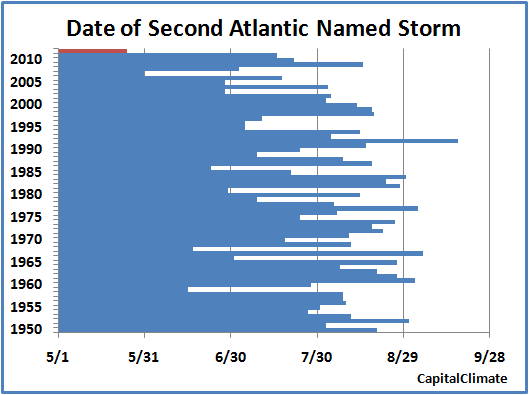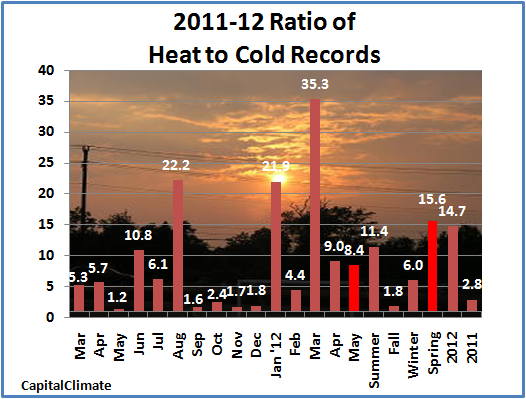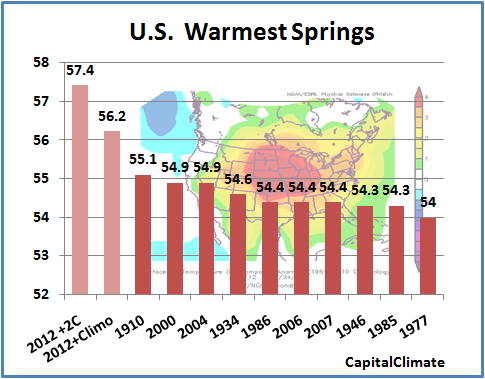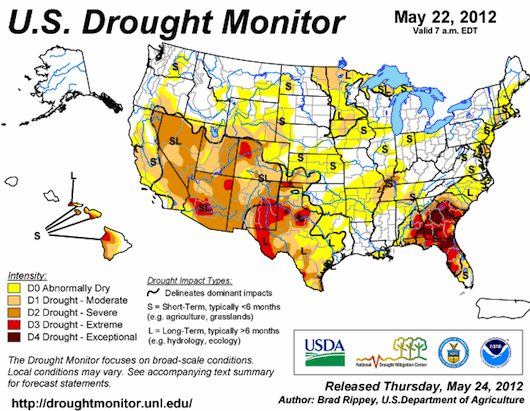Earliest Second Named Tropical Storm, Record-Smashing Heat Wave, Widespread Drought
The U.S. is being pummeled by a climate system on steroids. For the year to date, new heat records continue to beat cold records by a staggering 14.7 to 1, which trumps the pace of the last decade by a factor of 7!
And the U.S. southeast is being whipsawed from brutal drought to deluge (via tropical storm), which, curiously enough, is just what scientists have said global warming has started to do in the summertime, too.
Here are some charts that tells the story.

“The chart shows the date of formation for the second named Atlantic tropical cyclone of the season from 1950 through 2012. The average date through 2011 was August 1, so Beryl is nearly 10 weeks earlier than average.”
While warm Gulf stream waters have helped spin up Beryl, the heat has been socking the mainland U.S. all year, as this chart from Capital Climate shows:

Following a March heat wave that was “unmatched in recorded history” for the U.S. (and Canada), heat records continued to trump cold records by a huge amount in both April and May. I like the statistical aggregation across the country, since it gets us beyond the oft-repeated point that you can’t pin any one record temperature on global warming.
A 2009 analysis shows that the average ratio for the 2000s was 2.04-to-1, a sharp increase from previous decades. Lead author Dr. Gerald Meehl explained, “If temperatures were not warming, the number of record daily highs and lows being set each year would be approximately even.”
Many of the country’s leading climatologists and meteorologists have looked at the data and concluded that like a baseball player on steroids, our climate system is breaking records at an unnatural pace (see also “March Heat Records Crush Cold Records by Over 35 To 1, Scientists Say Global Warming Loaded The Dice”).
Climate Central has a great graphic of the record temperatures for any month that you can play around with, which I’ll post at the end. But first, as Capital Climate notes with the following chart, “the U.S. is well on its way to crush the record for warmest spring since national temperature data began in 1895”:

It would have to be staggeringly cold in the coming in the coming days for 2012 to not set the record.
Until Beryl, the Southeast, along with much of the country, was under a brutal drought, as last week’s U.S. Drought Monitor made clear:

No doubt this Thursday’s map will show significant improvement in parts of the southeast because of Beryl. But this whipsawing from drought to deluge and back is not good for farming or ecosystems or human health. Unfortunately, climate science suggests we are going to have to get used to it.
And the U.S. southeast is being whipsawed from brutal drought to deluge (via tropical storm), which, curiously enough, is just what scientists have said global warming has started to do in the summertime, too.
Here are some charts that tells the story.

“The chart shows the date of formation for the second named Atlantic tropical cyclone of the season from 1950 through 2012. The average date through 2011 was August 1, so Beryl is nearly 10 weeks earlier than average.”
While warm Gulf stream waters have helped spin up Beryl, the heat has been socking the mainland U.S. all year, as this chart from Capital Climate shows:

Following a March heat wave that was “unmatched in recorded history” for the U.S. (and Canada), heat records continued to trump cold records by a huge amount in both April and May. I like the statistical aggregation across the country, since it gets us beyond the oft-repeated point that you can’t pin any one record temperature on global warming.
A 2009 analysis shows that the average ratio for the 2000s was 2.04-to-1, a sharp increase from previous decades. Lead author Dr. Gerald Meehl explained, “If temperatures were not warming, the number of record daily highs and lows being set each year would be approximately even.”
Many of the country’s leading climatologists and meteorologists have looked at the data and concluded that like a baseball player on steroids, our climate system is breaking records at an unnatural pace (see also “March Heat Records Crush Cold Records by Over 35 To 1, Scientists Say Global Warming Loaded The Dice”).
Climate Central has a great graphic of the record temperatures for any month that you can play around with, which I’ll post at the end. But first, as Capital Climate notes with the following chart, “the U.S. is well on its way to crush the record for warmest spring since national temperature data began in 1895”:

It would have to be staggeringly cold in the coming in the coming days for 2012 to not set the record.
Until Beryl, the Southeast, along with much of the country, was under a brutal drought, as last week’s U.S. Drought Monitor made clear:

No doubt this Thursday’s map will show significant improvement in parts of the southeast because of Beryl. But this whipsawing from drought to deluge and back is not good for farming or ecosystems or human health. Unfortunately, climate science suggests we are going to have to get used to it.
You can return to the main Market News page, or press the Back button on your browser.

